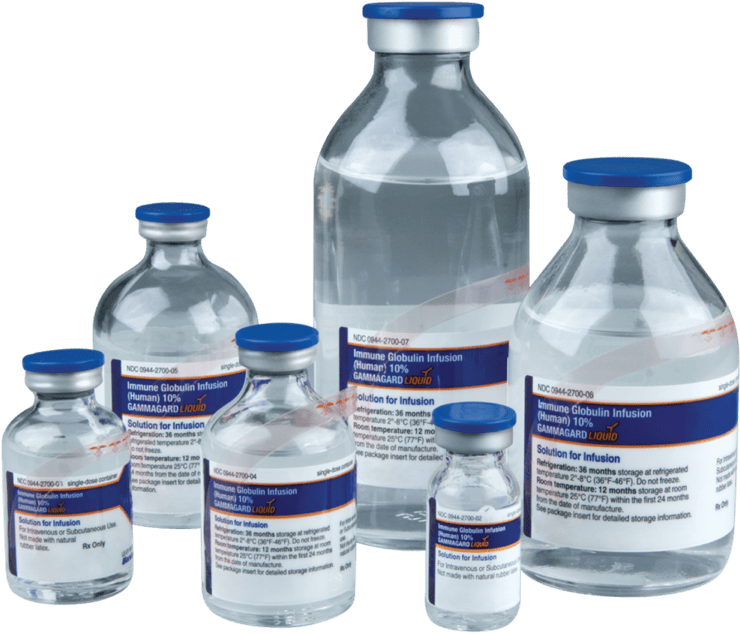GAMMAGARD LIQUID Product Characteristics
Explore the production process of GAMMAGARD LIQUID [Immune Globulin Infusion (Human) 10%]
Examine the creation of GAMMAGARD LIQUID, from the donor selection process to purification and the dedicated virus inactivation steps.
Before we get started, let’s go through some important safety information. Gammagard Liquid (Immune Globulin Infusion [Human] 10%) is indicated as replacement therapy for primary humoral immunodeficiency (PI) in adult and pediatric patients age 2 years and over, and as a maintenance therapy to improve muscle strength and disability in adult patients with Multifocal Motor Neuropathy (MMN). Thrombosis, Renal Dysfunction, and Acute Renal Failure are Boxed Warnings for Gammagard Liquid. Please see additional Important Safety Information in this video, and the accompanying Full Prescribing Information.
Want to see one of the world’s most precious assets?
No, it’s not a diamond, it’s not gold.
This is human plasma and it’s used to create immunoglobulin therapies, like Gammagard Liquid.
Pretty cool, huh?
But do you know how these therapies are made? Let me show you.
Precious things need to be handled with care. And this is no exception.
It’s not a process that can be rushed. No, No.
It’s a journey of dedication and care.
The process takes up to a year and follows rigorous quality and safety measures.
It begins with donor selection.
Potential donors are strictly screened before their plasma is collected and their donation is tested for viruses and infections.
Then, experts carefully remove the IgG antibodies that are needed to create the final product.
After this, they purify the IgG antibodies in several stages.
And, while donor screening and donation testing minimise the chances of viruses, three specialised steps clear any viruses that may still be there.
Immunoglobulin therapies are all produced in a similar way but their features are different.
Gammagard Liquid is designed with patient needs in mind.
Its specific characteristics make it suitable for a broad range of patients. For example, it doesn’t contain any added sugar or sodium, which may be important things to consider for patients who are watching their salt and sugar intake.
Looking good!
After a final inspection, Gammagard Liquid is shipped to the people it’s prescribed to.
People like me!
Doorman: After you.
INDICATIONS: GAMMAGARD LIQUID is indicated as replacement therapy for primary humoral immunodeficiency (PI) in adult and pediatric patients ≥2 years and as a maintenance therapy to improve muscle strength and disability in adult patients with Multifocal Motor Neuropathy (MMN).
IMPORTANT SAFETY INFORMATION
WARNING: THROMBOSIS, RENAL DYSFUNCTION, AND ACUTE RENAL FAILURE
Thrombosis may occur with immune globulin (IG) products, including GAMMAGARD LIQUID. Risk factors may include advanced age, prolonged immobilization, hypercoagulable conditions, history of venous or arterial thrombosis, use of estrogens, indwelling vascular catheters, hyperviscosity, and cardiovascular risk factors. Thrombosis may occur in the absence of known risk factors.
Renal dysfunction, acute renal failure, osmotic nephrosis, and death may occur in predisposed patients with immune globulin intravenous (IGIV) products. Patients predisposed to renal dysfunction include those with any degree of pre-existing renal insufficiency, diabetes mellitus, age greater than 65, volume depletion, sepsis, paraproteinemia, or patients receiving known nephrotoxic drugs. Renal dysfunction and acute renal failure occur more commonly in patients receiving IGIV products containing sucrose. GAMMAGARD LIQUID does not contain sucrose.
For patients at risk of thrombosis, administer GAMMAGARD LIQUID at the minimum dose and infusion rate practicable. Ensure adequate hydration in patients before administration. Monitor for signs and symptoms of thrombosis and assess blood viscosity in patients at risk of hyperviscosity.
CONTRAINDICATIONS
History of anaphylactic or severe systemic hypersensitivity reactions to human IG
IgA-deficient patients with antibodies to IgA and a history of hypersensitivity to human IG. Anaphylaxis has been reported with intravenous (IV) use of GAMMAGARD LIQUID.
WARNINGS AND PRECAUTIONS
Hypersensitivity: Severe hypersensitivity reactions may occur, even in patients who have tolerated previous treatment with human IG. If a hypersensitivity reaction occurs, discontinue infusion immediately and institute appropriate treatment. IgA-deficient patients with antibodies to IgA are at greater risk of developing potentially severe hypersensitivity reactions, including anaphylaxis.
Renal Dysfunction/Failure: Acute renal dysfunction/failure, acute tubular necrosis, proximal tubular nephropathy, osmotic nephrosis, and death may occur with IV use of IG products, especially those containing sucrose. Ensure patients are not volume depleted prior to infusion. In patients at risk due to pre-existing renal insufficiency or predisposition to acute renal failure, assess renal function before initiation and throughout treatment, and use the minimum infusion rate practicable for IV administration. If renal function deteriorates, consider discontinuation.
Hyperproteinemia, increased serum viscosity, and hyponatremia may occur. It is critical to distinguish true hyponatremia from a pseudohyponatremia because certain treatments may lead to volume depletion, a further increase in serum viscosity, and a predisposition to thromboembolic events.
Thrombosis: May occur following treatment with IG products and in the absence of known risk factors. In patients at risk, administer at the minimum dose and infusion rate practicable. Ensure adequate hydration before administration. Monitor for signs and symptoms of thrombosis and assess blood viscosity in patients at risk for hyperviscosity.
Aseptic Meningitis Syndrome: Has been reported with use of IG and may occur more frequently in females. Conduct a thorough neurological exam on patients exhibiting signs and symptoms, to rule out other causes of meningitis. Discontinuing IG treatment has resulted in remission within several days without sequelae.
Hemolysis: GAMMAGARD LIQUID contains blood group antibodies, which may cause a positive direct antiglobulin reaction and hemolysis. Monitor patients for signs and symptoms of hemolysis and delayed hemolytic anemia and, if present, perform appropriate confirmatory lab testing.
Transfusion-Related Acute Lung Injury: Non-cardiogenic pulmonary edema may occur with IV administered IG. Monitor patients for pulmonary adverse reactions. If suspected, perform appropriate tests for presence of anti-neutrophil and anti-HLA antibodies in both product and patient serum. May be managed using oxygen therapy with adequate ventilatory support.
Transmittable Infectious Agents: Because GAMMAGARD LIQUID is made from human plasma, it may carry a risk of transmitting infectious agents (e.g., viruses, other pathogens). No confirmed cases of viral transmission or variant Creutzfeldt-Jakob disease (vCJD) have been associated with GAMMAGARD LIQUID.
Interference with Lab Tests: False positive serological test results and certain assay readings, with the potential for misleading interpretation, may occur as the result of passively transferred antibodies.
ADVERSE REACTIONS
The most serious adverse reactions observed in clinical studies were aseptic meningitis, pulmonary embolism, and blurred vision.
The most common adverse reactions observed in ≥5% of subjects were:
IV administration for PI: headache, fatigue, pyrexia, nausea, chills, rigors, pain in extremity, diarrhea, migraine, dizziness, vomiting, cough, urticaria, asthma, pharyngolaryngeal pain, rash, arthralgia, myalgia, oedema peripheral, pruritus, and cardiac murmur.
Subcutaneous administration for PI: infusion site (local) event (rash, erythema, edema, hemorrhage, and irritation), headache, fatigue, heart rate increased, pyrexia, abdominal pain upper, nausea, vomiting, asthma, blood pressure systolic increased, diarrhea, ear pain, aphthous stomatitis, migraine, oropharyngeal pain, and pain in extremity.
IV administration for MMN: headache, chest discomfort, muscle spasms, muscular weakness, nausea, oropharyngeal pain, and pain in extremity.
DRUG INTERACTIONS
Passive transfer of antibodies may transiently interfere with immune responses to live attenuated virus vaccines (e.g., measles, mumps, rubella, and varicella).
Please see the accompanying Full Prescribing Information provided with this material or on the Gammagard Liquid website www.gammagard.com/hcp
Not all intravenous immune globulin (IVIG) formulations are interchangeable1-3
The final formulation can differ among IVIGs, meaning they are not interchangeable.1,3 When selecting an IVIG treatment, individual patient characteristics should be considered.1,3
IVIG treatments are distinct plasma products with patient tolerance differing from one brand to another. Not all IVIG treatments are biologically equivalent, and caution should be used when changing products.1,3
Predisposition for renal insufficiency1,4-6
- Diabetes mellitus
- Elderly
- Hypovolemia
- Sepsis
- Paraproteinemia
- Concomitant therapy with nephrotoxic drugs
| Sodium content | Sugar content | Osmolality | lgA | Volume load |
|---|---|---|---|---|
Heart disease1,8-10
- Thromboembolic risk factors
- Coronary artery disease
- Heart failure
- Hypertension
- Hyperlipidemia
- Cardiovascular risk factors
| Sodium content | Sugar content | Osmolality | lgA | Volume load |
|---|---|---|---|---|
Diabetes mellitus5
- Type 1
- Type 2
| Sodium content | Sugar content | Osmolality | lgA | Volume load |
|---|---|---|---|---|
Elderly1,11
- Generally considered as >65 years of age
| Sodium content | Sugar content | Osmolality | lgA | Volume load |
|---|---|---|---|---|
IgA deficiency1
- IgA-deficient patients with antibodies to IgA and a history of hypersensitivity
- All patients, since an IgA concentration that will provoke a reaction is unknown; even trace amounts of IgA present a risk of anaphylaxis
| Sodium content | Sugar content | Osmolality | lgA | Volume load |
|---|---|---|---|---|
Volume intake restrictions1,9
- Hyperviscosity risk factors
- Cardiac impairment
- Renal impairment
- Pulmonary edema
- Hypertension
- Elderly
| Sodium content | Sugar content | Osmolality | lgA | Volume load |
|---|---|---|---|---|
GAMMAGARD LIQUID is formulated with patient needs in mind12
No added sodium
No added sugar
No preservatives
No latex
Osmolality 240-300 mOsmol/kg, similar to physiologic levels
IgA average
concentration of
37 µg/mL
pH range of 4.6-5.1
Glycine stabilized

GAMMAGARD LIQUID is designed
for ease of use
GAMMAGARD LIQUID offers convenient vial size options and storage.12
See vial and storage infoReview the product characteristics for 12 IVIG treatments
Review the product characteristics of 12 distinct IVIG treatments. Download to save or print for easy reference. Please note, this chart provides product characteristics only and does not imply clinical outcomes.
Download product characteristics chart